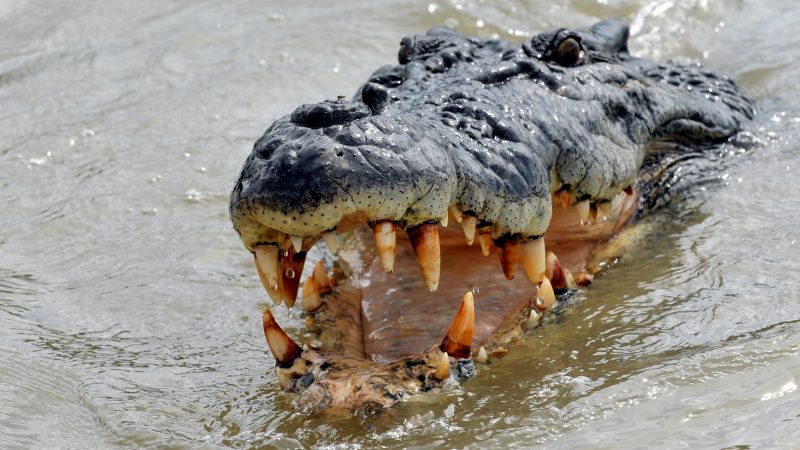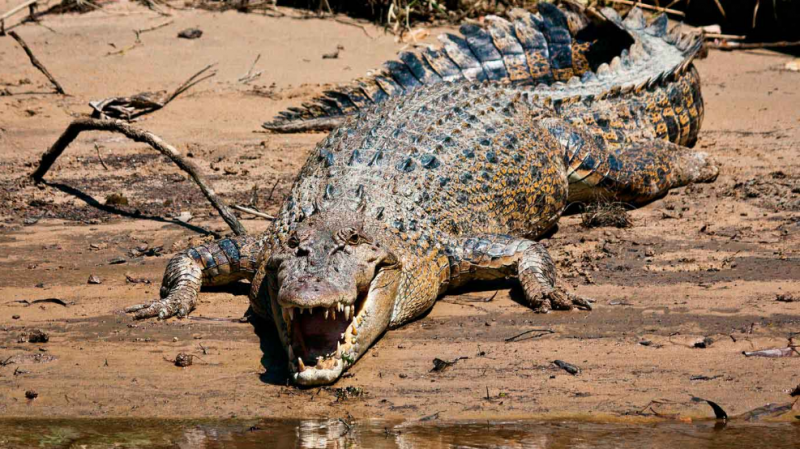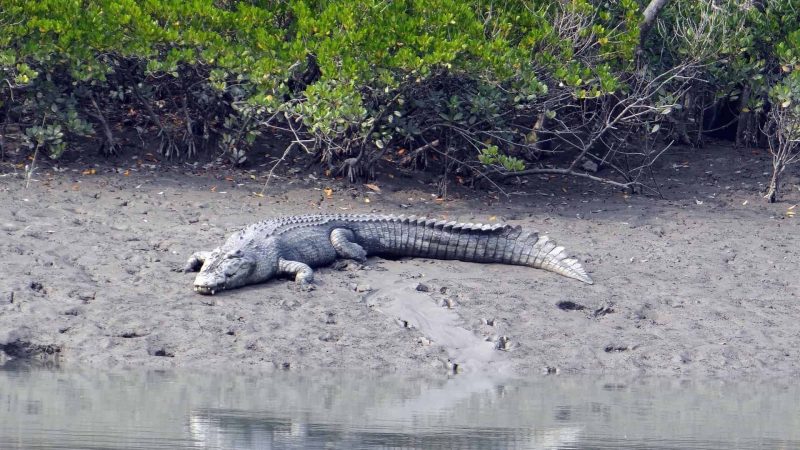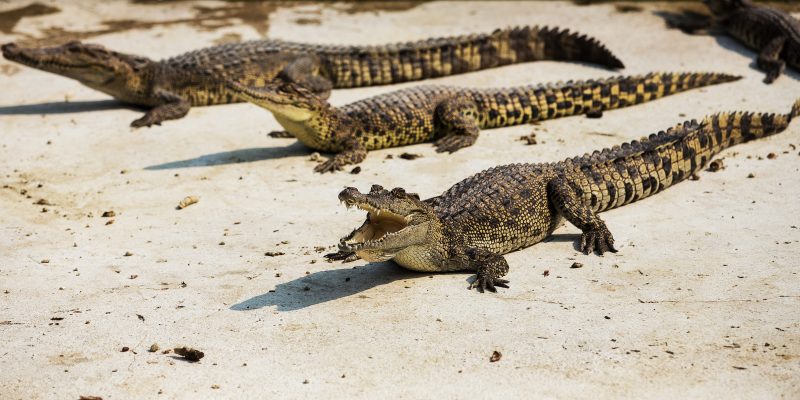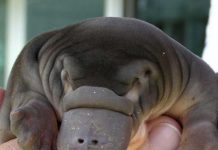Gigantic lizards, awe of people and animals with their sizes and unsurpassed hunting abilities, are crocodiles. The largest representative of this family is the so-called combed crocodile. Why did he get such a name, and what is the lifestyle of these predators? More details in our article.
Material Content:
Description and features of the combed crocodile
Saltwater crocodile (Crocodylus porosus) is also called marine. He is the most prominent member of the family. These animals have earned a reputation as the largest and most severe reptiles among their fellow crocodile tribesmen.
The combed crocodiles and their closest relatives, alligators, caimans and gavials, have an impressive pedigree - their ancestors were the dinosaurs themselves.
The ancient lizards, however, were superior to modern crocodiles in size, reaching a length of 13 m. It is on the example of crocodiles that humanity can imagine the appearance of ancient extinct animals. Over the past hundreds of thousands of years, crocodiles have changed little and still resemble their ancient relatives in appearance and habits.
Anatomy and physiology
The combed crocodile is named so for a reason. His head is crowned by two rows of ridges located in the middle of the crocodile face and extending from the eyes to the nostrils. Young individuals do not have such ornaments - only adult animals wear combs.
A marine crocodile is distinguished from its contemporaries by the presence of small scales on its belly. Such "chain mail" is not subjected to the process of ossification, that is, it does not turn into osteoderm.
- When born, crocodiles weigh no more than 70 g, and their body length is 30 cm.
- Males are considered capable of breeding, reaching a length of 3 m, females - 2 m.
- Some adult crocodiles can grow up to 6 m and weigh about 1000 kg.
- On average, the length of the crocodile is 4 - 5 m, weight - 450 - 800 kg. Females are more tiny, reaching 2 - 3.5 m and weighing 450 kg.
Yellowish scales evenly cover the entire body of the lizard, and dark spots form on its tail and body. In sexually mature individuals, the skin becomes darker, eventually acquiring a greenish-gray hue with brown spots. Crocodile belly is yellow-gray, the tail is colored in dark stripes.
Note. Crocodiles even resemble their dinosaur ancestors in the structure of the skull. The organs of hearing and touch of this dinosaur are located in the immediate vicinity of the crown. This feature helps crocodiles to be under water for a long time, putting their nostrils out. Watching in this way what is happening on the shore, the crocodile senses the prey located many meters from it.
Lifestyle & Habitat
Sea crocodiles can live both fresh and in salt water. At the same time, reptiles can be found on the ocean coast, in lakes, swamps, rivers. Able to swim far into the sea, the pangolin easily drifts from coast to coast. But most often, crested creatures live in deep water.
Special glands with which the crocodile is “equipped” help it to remove salt from the body. Due to this feature, the animal can live in salt water, but he can’t drink it. He receives the missing moisture from the extracted food.
These predators are considered loners - each of them has its own "premises" within the reservoir. On land, crocodiles move slowly, at a speed of 3-5 km / h, but in water they can accelerate to 30 km / h.
In the afternoon, toothy reptiles bask in the water, preferring to hunt early in the morning or at dusk. Most comfortable crocodiles feel in a tropical climate, and therefore are able to migrate when the onset of cold weather.
Sea crocodiles live in the Indian and Pacific Oceans. They can also be found in the coastal waters of Sri Lanka, New Guinea, India, Vietnam, Indonesia, the East and Southeast Asia. But the largest concentrations of these predators are recorded in northern Australia. Able to swim quickly, these crocodiles reach the coast of the Philippines or Japan.
The behavior and nutrition of reptiles
This species of reptile feeds on mammals, fish and birds. Individuals living in the seas can easily cope even with a white shark. Adult predators kill buffaloes, antelopes and other large horned animals. Also, their menu may include wild boars, leopards, monkeys, crabs, snakes. Cubs eat fish, insects, mollusks. In hungry periods, this animal is able to commit an act of cannibalism by eating its own kind.
These predators have interesting eating habits. Crocodiles don’t eat large prey right there. Tightening the victims to the depths, they place them under snags and stones to prevent ascent. When the meat begins to decompose, the lizard begins to eat. However, there are frequent cases when the prey hidden in this way goes to other carnivores.
When hunting, the crocodile disguises itself in water, waiting for the victim to approach. Suddenly attacking prey, the predator knocks it off its feet with a tail strike or captures it with its powerful jaws. The reptile drags the defeated animal into deep water until the victim is completely drowned.
Bite force, attack on people
The terrible crocodile's mouth is equipped with conical teeth 5 cm long each. Inside them there are cavities in which new chewing units subsequently form when the old ones wear out. The total number of teeth can reach hundreds.
A combed crocodile is the most dangerous member of its family for people. About 2,000 people become its victims each year. The largest number of attacks recorded on the coast of Australia.
It is interesting. In 1945, combed crocodiles staged a real bloody massacre on Ramry Island. 1000 Japanese soldiers attempting to cross the local swamps were attacked by toothy creatures. Only a few dozen military managed to escape.
The sea lizard is the record holder for the power of the jaws among all animals living on the planet. So, the strength of a crocodile bite is 16,480 Newtons, or 251 atmospheres. For comparison, the strength of a jaguar bite is 136 atmospheres, the hippo is 124.
Large individuals often attack pleasure boats and bite them without difficulty.
Reproduction and longevity
With the onset of the mating season, crocodiles become extremely inventive in matters of flirting. To attract females, males make various movements, slap their faces in the water, make characteristic sounds resembling croaking. In a short period after mating, the female lays 40-60 eggs in a previously dug clutch.
The crocodile is an example of true maternal dedication. After all, after burying eggs in the sand, it is continuously near them for almost 3 months, while remaining hungry. The female hatches the young with extreme caution in its mouth to water.
It is interesting. Moving to the water, the female crocodile can transfer newborn turtles along with her children. Their parents often lay their eggs near the crocodile, considering the formidable toothy mother an excellent guard.
Crocodiles are long-lived predators living in the wild for about 60 - 80 years.
Red Book, interesting facts
Saltwater crocodiles are inhabitants of the Red Book, because at the end of the last century their population was balancing on the verge of complete extinction. And all because of the value of the crocodile skin, which made these predators the target of poachers and hunters. Now the law restricts hunting for large dinosaurs.
Many years of experience observing crocodiles by naturalists allows us to highlight several interesting facts about them:
- In the literal translation, "crocodile" means "pebble worm." There are several explanations for this name. The most common version is the similarity of scales on a crocodile body with small pebbles - pebbles.
- Crocodiles grow and increase in size all their lives. This is due to the continuous growth of cartilage.
- Being in the water, reptiles are not able to close their mouths. At the same time, water does not enter the body of the predator due to the presence of secondary bone palate. The so-called palatine curtain performs the function of a valve, and the crocodile is able to breathe through the nostrils exposed to the surface of the water.
- The stomach of the crocodile is equipped with gastrolites - the so-called "stomach stones". They help him grind hard food and shift the center with a crocodile of gravity while swimming.
- Crocodile is one of the few animals that have not practically changed in appearance since prehistoric times. This is explained by the way of life of reptiles - both then and now they lived and live in the water. It was such a habitat that saved the dinosaurs life, since the waters of the World Ocean almost always maintained approximately the same temperature.
- The largest combed crocodile in the world was caught in the Philippines in 2011. The length of the body of the predator was 6.17 m, weight - 1075 kg.
Terrible combed crocodiles are beautiful and dangerous creatures. Direct descendants of dinosaurs, these dinosaurs are cunning and fearless. Both animals and people can become victims of the reptile - powerful jaws allow the crocodile to choose an object for hunting at its own discretion.



